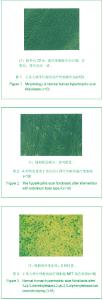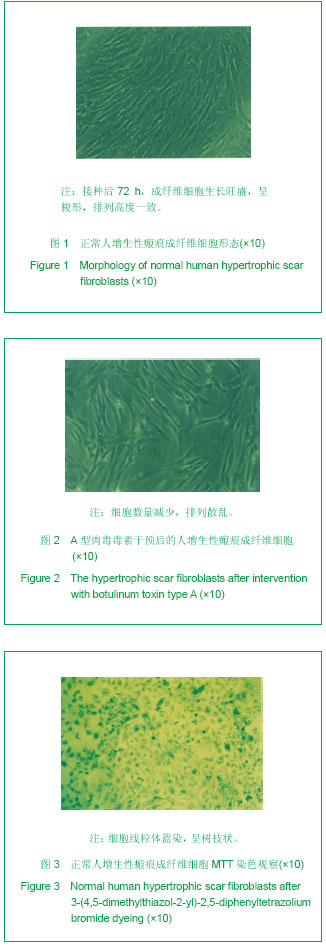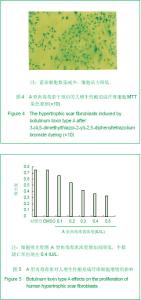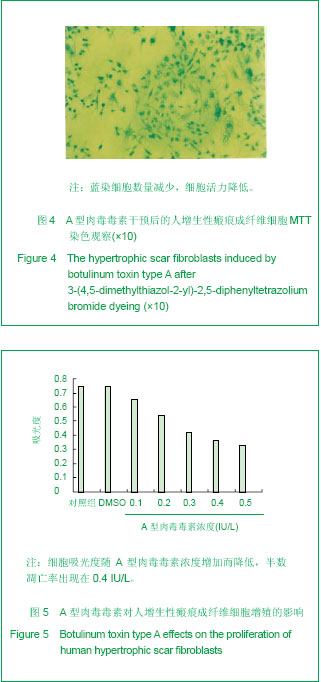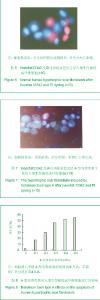Chinese Journal of Tissue Engineering Research ›› 2013, Vol. 17 ›› Issue (24): 4429-4435.doi: 10.3969/j.issn.2095-4344.2013.24.009
Previous Articles Next Articles
Botulinum toxin type A induces apoptosis of human hypertrophic scar fibroblasts
Li Wei-hua1, Gao Yu-wei2, Li De-shui1, Xing Yu-xi1
- 1 Department of Burn and Plastic Surgery, the Affiliated Hospital of Logistic College of Chinese People’s Armed Police Force, Tianjin 300162, China
2 Department of Plastic Surgery, Xingtai Boai Hospital, Xingtai 054001, Hebei Province, China
-
Received:2012-09-30Revised:2012-10-10Online:2013-06-11Published:2013-06-11 -
About author:Li Wei-hua★, Master, Associate chief physician, Department of Burn and Plastic Surgery, the Affiliated Hospital of Logistic College of Chinese People’s Armed Police Force, Tianjin 300162, China lwh_689@yahoo.com.cn
CLC Number:
Cite this article
Li Wei-hua, Gao Yu-wei, Li De-shui, Xing Yu-xi. Botulinum toxin type A induces apoptosis of human hypertrophic scar fibroblasts[J]. Chinese Journal of Tissue Engineering Research, 2013, 17(24): 4429-4435.
share this article
| [1] Wu BJ, Wu JM, Lin ZH, et al. Zhonghua Shaoshang Zazhi. 2006;22(06):469-470.吴包金,吴建明,林子豪,等.增生性瘢痕退行性变过程中的细胞凋亡和相关基因表达[J].中华烧伤杂志,2006,22(06):469-470.http://www.cnki.com.cn/Article/CJFDTotal-ZHSA200606028.htm[2] Wang L, Tai NZ, Fan ZH, et al. ZHonghua Zhengxing Waike Zazhi. 2009;4:284-287.王琳,邰宁正,范志宏, 等. A型肉毒毒素对兔耳增生性瘢痕组织中P物质、β1转移生长因子、α平滑肌肌动蛋白的影响[J].中华医学美学美容杂志,2009,6:410-413.http://www.cqvip.com/QK/71135X/201107/32577654.html[3] Wang L, Tai NZ, Fu MG, et al. Zhonghua Zhengxing Waike Zazhi. 2009;25(3):222-223.王琳,邰宁正,傅敏刚,等.A型肉毒毒素注射治疗瘢痕疙瘩患者的顽固性痛痒[J].中华整形外科杂志,2009,25(3): 222-223.http://www.cqvip.com/QK/71135X/201107/30537397.html[4] Zhao BC, Qian L. Hunana Yike Daxue Xuebao. 2000;25(1): 73-76.赵柏程,钱利.增生性瘢痕和瘢痕疙瘩组织中细胞凋亡与增殖的研究[J].湖南医科大学学报,2000,25(1):73-76.http://www.cnki.com.cn/Article/CJFDTotal-HNYD200001027.htm[5] Yu B, Chen ML, Liu WG, et al. Zhonghua Yixue Meixue Meirong Zazhi. 2008;14(2):95-101.于波,陈敏亮,刘文阁,等.A型肉毒毒素预防与治疗早期增生性瘢痕的临床研究[J].中华医学美学美容杂志,2008,14(2):95-101.http://med.wanfangdata.com.cn/News/Article/1/1826.aspx[6] Gauqlitz GG, Bureik D,Dombrowski Y,et al. Botulinum toxin a for the treatment of keloids. Skin Pharmacol Physiol. 2012;25 (6):318-319.http://www.ncbi.nlm.nih.gov/pubmed/22948093[7] Li WH, Li DS, Gao YW, et al. Zhonguo Zuzhi Gongcheng Yanjiu. 2012;16(20):3667-3670.李卫华,李德水,高玉伟,等.A型肉毒毒素可抑制人增生性瘢痕成纤维细胞增殖和胶原蛋白合成[J].中国组织工程研究,2012,16 (20): 3667-3670.http://www.cnki.com.cn/Article/CJFDTotal-XDKF201220022.htm[8] Haubner F, Ohmann E, Müller-Vogt U, et al. Effects of botulinum toxin a on cytokine synthesis in a cell culture model of cutaneous scarring. Arch Facial Plast Surg. 2012;14(2):122-126.http://www.ncbi.nlm.nih.gov/pubmed/22006235[9] Hevia O.Retrospective review of 500 patients treated with abobotulinumtoxin A.J Drugs Dermatol. 2010;9(9):1081-1084.http://www.ncbi.nlm.nih.gov/pubmed/20865838[10] Levy NS, Lowenthal DT. Application of botulinum toxin to clincal therapy: advances and cautions. Am J Ther. 2012; 19(4): 281-286.http://www.ncbi.nlm.nih.gov/pubmed/22481607[11] Dresslor D. Parmacology of botulinum toxin drugs. HNO.2012; 60(6):496-504.http://www.ncbi.nlm.nih.gov/pubmed/23054049[12] Cable MM. On the front lines: What’s new in botox and facial fillers. Mo Med.2010;36:2121-2134.http://www.ncbi.nlm.nih.gov/pubmed/21319685[13] Beer Kr. Combined treatment for skin rejuvenation and soft-tissue augmentation of the aging face. J Drugs Dermatol. 2011;10(2):125-132.http://www.ncbi.nlm.nih.gov/pubmed/21283916[14] Goldman A, Wollina U. Facial rejuvenation for middle-aged women: a combined approach with minimally invasive procedures. Clin Interv Aging.2010;23(5):293-299.http://www.ncbi.nlm.nih.gov/pubmed/20924438[15] Raspaldo H, Baspeyras M,Bellity P,et al.Upper- and mid-face anti-aging treatment and prevention using onabotulinumtoxin A: the 2010 multidisciplinary French consensus—part 1. J Cosmet Dermatol.2011;10(1):36-50.http://www.ncbi.nlm.nih.gov/pubmed/21332914[16] Sepehr A,Chauhan N,AlexanderAJ,et al.Botulinum toxin type a for facial rejuvenation: treatment evolution and patient satisfaction.Aesthetic Plast Surg.2010;34(5):583-586.http://www.ncbi.nlm.nih.gov/pubmed/20383497[17] Andrade NN, Deshpande GS. Use of botulinum toxin (botox) in the management of masseter muscle hypertrophy: a simplified technique. Plast Reconstr Surg.2011;128(1):24-26.http://www.ncbi.nlm.nih.gov/pubmed/21701301[18] Pary A,Pary K.Masseteric hypertrophy: considerations regarding treatment planning decisions and introduction of a novel surgical technique. J Oral Maxillafac Surg.2011;69(3): 944-949.http://www.ncbi.nlm.nih.gov/pubmed/21195532[19] Jaspers GW, Pijpe J, Jansma J.The use of botulinum toxin type A in cosmetic facial procedures. Int Oral Maxillofac Surg. 2011; 40(2):127-133.http://www.ncbi.nlm.nih.gov/pubmed/20965695[20] Kim NH, Park RH, Park JB. Botulinum toxin type A for the treatment of hypertrphy of the masseter muscle. Plast Reconstr Surg.2010;125(6):1693-1705.http://www.ncbi.nlm.nih.gov/pubmed/22842446[21] Lee BJ,Jeong JH,Wang SG,et al.Effect of botulinum toxin type a on a rat surgical wound model.Clin Exp Otorhinolaryngol. 2009; 2(1):20-27.http://www.ncbi.nlm.nih.gov/pubmed/19434287[22] Venus MR.Use of botulinum toxin type A to prevent widening of facial scars.Plast Reconstr Surg. 2007;19(1):423-424.http://www.ncbi.nlm.nih.gov/pubmed/16651948[23] Gassner HG,Brissett AE,Otley CC,et al.Botulinum toxin to improve facial wound healing:A prospective,blinded, placebo-controlled study. Mayo Clin Proc.2006;81(8): 1023-1028.http://www.ncbi.nlm.nih.gov/pubmed/16901024[24] Wang L, Tai NZ, Fan ZH. Zhonghua Zhengxing Waike Zazhi. 2009;25(1):50-53. 王琳,邰宁正,范志宏.肉毒毒素A对大鼠皮肤及创面组织中SP、CGRP、TGF-β1和α-SMA的影响[J].中华整形外科杂志, 2009, 25(1):50-53.http://www.cqvip.com/QK/96147A/200901/29450569.html[25] Xiao Z, Zhang F, Lin W, et al. Effect of botulinum toxin type A on transforming growth factor beta 1 in fibroblasts derived from hypertrophic scar: a preliminary report. Aesthetic Plast Surg. 2010;34(4):424-427.http://www.ncbi.nlm.nih.gov/pubmed/19802513[26] Penn JW, Grobbelaar AO, Rolfe KJ. The role of the TGF-β family in wound healing, burns and scarring: a review. Int J Burns Trauma. 2012;2(1):18-28.http://www.ncbi.nlm.nih.gov/pubmed/22928164[27] Huang C, Akaishi S, Oqawa R. Mechanosignaling pathways in cutaneous scarring. Arch Dermatol Res.2012;304(8): 589-597.http://www.ncbi.nlm.nih.gov/pubmed/22886298[28] Abe M, Yokoyama Y, Ishikawa O. A possible mechanism of basic fibroblast growth factor-promoted scarless wound healing: the induction of myofibroblast apoptosis. Eur J Dermatol. 2012;22(1):46-53.http://www.ncbi.nlm.nih.gov/pubmed/22370167[29] Hounardoust D, Varkey M, Marcoux Y, et al. Reduced decorin, fibromodulin, and transforming growth factor-β3 in deep dermis leads to hypertrophic scarring. J Burn Care Res. 2012; 33(2):218-227.http://www.ncbi.nlm.nih.gov/pubmed/22079916[30] Liu J, Wang Y, Pan Q, et al. Wnt/β-catenin pathway forms a negative feedback loop during TGF-β1 induced human normal skin fibroblast-to-myofibroblast transition. J Dermatol Sci. 2012;65(1):38-49.http://www.ncbi.nlm.nih.gov/pubmed/22041457[31] Moon H , Yong H, Lee AR. Optimum scratch assay condition to evaluate connective tissue growth factor expression for anti-scar therapy. Arch Pharm Res. 2012;35(2):383-388.http://www.ncbi.nlm.nih.gov/pubmed/22370794[32] Guo F, Cater DE, Leask A. Mechanical tension increases CCN2/CTGF expression and proliferation in gingival fibroblasts via a TGFβ-dependent mechanism. Plos One. 2011;6(5):e19756.http://www.ncbi.nlm.nih.gov/pubmed/21611193[33] Tao L, Liu J, Li Z, et al. Role of the JAK-STAT pathway in proliferation and differentiation of human hypertrophic scar fibroblasts induced by connective tissue growth factor. Mol Med Report. 2010;3(6):941-945.http://www.ncbi.nlm.nih.gov/pubmed/21472337[34] Zhibo X,Miaobo Z.Botulinum toxin type A affects cell cycle distribution of fibroblasts derived from hypertrophic scar. J Plast Reconstr Aesthetic Surg.2008;61(9):1128-1129.http://www.ncbi.nlm.nih.gov/pubmed/18555763[35] Chen W, Fu XB, Zhou G, et al. Zhonghua Shiyong Waike Zazhi. 2004;21(9):1111-1113.陈伟,付小兵,周岗,等. 增生性瘢痕内3种成纤维细胞生长因子及其受体基因的表达[J]. 中华实验外科杂志,2004,21(9): 1111-1113.http://www.cnki.com.cn/Article/CJFDTotal-ZHSY200409040.htm[36] Jiang ZY, Fu XB, Sheng ZY, et al. Zhonghua Waike Zazhi. 2006,44(07):496-498.姜笃银,付小兵,盛志勇.瘢痕组织愈合中成纤维细胞凋亡抗性及其临床意义[J].中华外科杂志,2006,44(07):496-498.http://www.cnki.com.cn/Article/CJFDTotal-ZHWK200607017.htm |
| [1] | Zhao Jia, Sun Jian-ping, Gao Yan-xia, Tang Ni-na, Niu Meng, Cui Meng, Han Xiao-qing, Sui Ai-hua . Platelet-derived growth factor-DD induces the proliferation and differentiation of rat renal fibroblasts into myofibroblasts [J]. Chinese Journal of Tissue Engineering Research, 2015, 19(11): 1688-1693. |
| [2] | Zhang Qiang, Wang Hong-ling, Ding Xian, Xia Chen-lei, Liu Li-juan, Wang Shuang-yu, Li Jian-ping, He Miao, Sun Wen-na, Yan Xiao, Liu Wen, Zhang Yue, Yao Ru-yong, Yuan Xiao. Effects of cyclic stretch on in vitro culture-tensile stimulation models of myoblasts [J]. Chinese Journal of Tissue Engineering Research, 2014, 18(5): 669-674. |
| [3] | Wu Guang-wen, Ye Jin-xia, Zheng Chun-song, Chen Wen-lie, Liu Xian-xiang, Ye Hong-zhi . Effect of Tougu Xiaotong capsule on articular cartilage changes in rat models of osteoarthritis [J]. Chinese Journal of Tissue Engineering Research, 2014, 18(49): 7924-7929. |
| [4] | Li Nan, Kong Meng-long, Ma Tao, Li Jia-fu, Ma Shao-lin. Effect of Uighur medicine abnormal savda munzip on hypertrophic scar and transforming growth factor beta/Smad signal transduction pathway [J]. Chinese Journal of Tissue Engineering Research, 2014, 18(46): 7391-7395. |
| [5] | Zhang Ming-zhu, Wang Jian-hua, Li Hu, Dong Yun-feng, Qi Chang-chun, Guo Bao-wen, Wang Yong-ling, Liu Xiao-yan, Li Yun-feng, Zhang Xiao-hui, Liu Ying, Li Xing-hua, Wang Hong-feng, Yu Qiang. Thin-thickness versus blade-thickness micro-skin pulping covered with heterogeneous skin for repair of burn wounds [J]. Chinese Journal of Tissue Engineering Research, 2014, 18(46): 7417-7421. |
| [6] | Wu Ling-zhi, Li Shui-bin, Cheng Gang-wei, Wang Hua-qiao, Kong Ling-ping. Apoptosis of human embryonic cerebral cortex neurons transfected with human telomerase reverse transcriptase [J]. Chinese Journal of Tissue Engineering Research, 2014, 18(29): 4653-4657. |
| [7] | Tian Liang, Qiu Lin, Fu Yue-xian, Tian Xiao-fei, Liu Yan, Xiao Jun. New biological dermis cover Pelnac® in wound healing of children with severe trauma [J]. Chinese Journal of Tissue Engineering Research, 2014, 18(16): 2601-2606. |
| [8] | Chen Xuan-huang, Li Rong-yi, Zhang Guo-dong, Lin Hai-bin, Wu Xian-wei, Lin Yu-jin, Zheng Feng . Possible mechanisms of cholecystokinin promoting sciatic nerve regeneration [J]. Chinese Journal of Tissue Engineering Research, 2014, 18(11): 1700-1705. |
| [9] | Li Ying, Gong Ya-fei, Chen Xin-jie. Biological properties of C57BL/6 mouse embryonic fibroblasts and preparation of feeder layers [J]. Chinese Journal of Tissue Engineering Research, 2014, 18(11): 1737-. |
| [10] | Yue Wei, Zhu Guo-bin, Du Qiu-xiang, Guo Zheng. Calcitonin gene-related peptide affects cardiomyocyte apoptosis of neonatal rats induced by oxidized low-density lipoprotein and hypoxia/reoxygenation [J]. Chinese Journal of Tissue Engineering Research, 2014, 18(11): 1761-1764. |
| [11] | Liu Yun-song, Deng Xu-bin, Huo Shao-fen, Su Lei. Activation of nuclear factor kappa B during heat stress-induced neuronal apoptosis [J]. Chinese Journal of Tissue Engineering Research, 2014, 18(11): 1641-1646. |
| [12] | Li Rui-qi, Zhang Guo-ping, Ren Li-zhong, Li Ya-li, Lü Ya-jun. Evaluation of bone marrow mesenchymal stem cells for the treatment of osteonecrosis of femoral head [J]. Chinese Journal of Tissue Engineering Research, 2013, 17(35): 6327-6332. |
| [13] | Wang Min, Lan Ya, Hu Hao, Shi Yong-quan, Han Ying, Zhou Xin-min. In vitro establishment of a three-dimensional hepatocyte culture system using collagen hydrogel as scaffolds [J]. Chinese Journal of Tissue Engineering Research, 2013, 17(29): 5323-5330. |
| [14] | Wei Wei, Shi Geng-hu, Li Yu-tang, Zhang Bing, Gao Chuang. Research and application progress of visual fixation component separation [J]. Chinese Journal of Tissue Engineering Research, 2013, 17(24): 4553-4560. |
| [15] | . Culture of bone marrow mesenchymal stem cells plus allogenic decalcified bone matrix in the knee cavity of rabbits for tissue engineered cartilage [J]. Chinese Journal of Tissue Engineering Research, 2013, 17(24): 4371-4379. |
| Viewed | ||||||
|
Full text |
|
|||||
|
Abstract |
|
|||||
